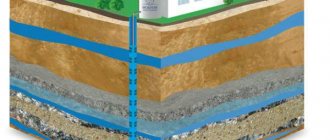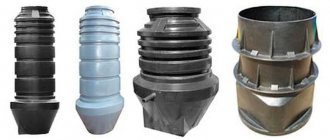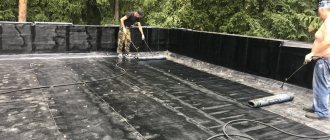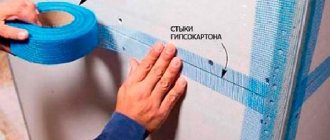The use of special reinforced concrete blocks when constructing a well shaft on their own forces summer residents to think about how to lower the rings into the well without a tap. Following the builders' recommendations while observing safety requirements will allow you to complete the procedure yourself.
Loading concrete rings into the well.
Well rings: features, characteristics, installation
Self-construction of a well is easier and more convenient using reinforced concrete well rings. Of course, these rings are different, and we want to tell you which products are best to choose, how to lower the rings into the well and how best to fix them in a column.
To prevent the rings from getting stuck in the well, they are suspended using chucks.
Reinforced concrete rings
Purpose
Well rings are designed to strengthen the shaft shaft.
Reinforced concrete rings for well structures are products made of heavy grade reinforced concrete, cylindrical in shape with a void inside. To put it simply, the ring resembles a short piece of pipe, the length of which is approximately equal to the diameter.
The well ring is intended for the construction of a casing column for a mine shaft:
- sewer,
- drainage,
- observation,
- or water well,
- as well as for the construction of septic tanks,
- various collectors,
- and other underground reservoirs.
Construction of a septic tank made of reinforced concrete rings.
In other words, reinforced concrete rings are used for the construction of prefabricated reinforced concrete structures, most often these are vertical columns made up of products standing on top of each other, fastened together with brackets, mortar or their own weight.
Most often, such products are used for the construction of the following structures:
- Wells for the extraction of drinking water . Here we need the highest quality products, both in terms of strength and reliability, and in composition, because they will come into contact with the food product;
- Sewage wells . For the construction of these structures, products of lower quality are allowed, since the depth of such tanks is small and there is no contact with drinking water;
- Stormwater and inspection drainage wells . The same as with sewer lines;
- Septic tanks . Here, increased requirements are put forward for the strength and reliability of connections, since this tank contains sewage, the penetration of which beyond the structure is unacceptable;
- Collectors of storm sewer and drainage system . These structures are subject to high requirements for water resistance and strength.
Important! So, we can say that reinforced concrete rings are used for the construction of various hydraulic structures and strengthening the vertical shafts of well shafts.
Characteristics
The height of the well ring and its internal diameter are among the main characteristics of the product.
Precast concrete products for the construction of well shafts have a wide range of characteristics. The main ones include the height of the product, its internal diameter, as well as mass, volume and wall thickness.
The first two characteristics are indicated on the ring markings. It consists of the letters KS and two numbers. “KS” stands for “wall ring”, and the numbers indicate the internal diameter (the first in order) and the height of the part (the second number). For example, a product marked KS 10-9 has an internal diameter of 10 decimeters and a height of 9 decimeters.
The photo shows reinforced concrete products KS 10-9 with a lock for the construction of wells.
The dimensions of reinforced concrete products can be very different: height ranges from 1 to 12 dm, internal diameter - from 7 to 25 dm. For the construction of water storage wells, products marked KS 10-9 are most often used, since they have an optimal width, and 90 cm in height gives a total weight of 550 to 630 kg, which is also quite acceptable.
You can use a table to determine the mass of products.
The wall thickness can vary from 8 to 10 cm; in addition, the ends of the ring can be smooth or have a flange-shaped lock. Locks allow you to make stronger structures and avoid horizontal displacements of the column during soil heaving.
The wall thickness is equal to the difference between the outer and inner diameters of the pipe.
The volume of the product can be easily determined using the formula:
V = S*h, where V is the volume, S is the area of the base of the cylinder, h is the height of the cylinder.
Formula for calculating the volume of a cylinder.
The height is indicated on the markings, but how to determine the base area? Elementary:
S = πR2, where π = 3.14, R = ½ D, D is the diameter indicated on the marking.
As a result, we get: V = 0.785*D2*h, and D is the first number in the marking, h is the second number in the part marking.
For example, let’s calculate how many liters are in the ring of the KS 10-9 well:
V = 0.785*1*0.9 = 0.7065 cubic meters m. = 700 l.
In some products, the height may be 89 cm, respectively, the volume will be slightly lower.
Types of reinforced concrete products by type of connection.
The same calculation can be used to calculate the volume of water in the water receiving part of the trunk, only instead of the height of the ring, you should substitute the height of the water column, which can be easily determined by lowering a rope with a weight into the well and then measuring the length of the wet part.
To deepen or not to deepen?
Drilling a dry well with your own hands is a very difficult and costly task, both in time and money. That is why it is extremely important to determine the feasibility of a future event.
First of all, you need to answer a few questions:
- A decrease in the amount of water in the well cannot be associated with the weather: prolonged frosts or prolonged drought.
- The water remaining in the well retained its quality. It has no foreign odors, is tasty and clean. If this is not the case, the bottom filter may become silted. The problem can be solved by proper cleaning.
- The water level in nearby wells has not changed.
If the answer to all questions is positive, it is quite possible that the problem is in your well, and it needs to be deepened. But there is still no need to rush to start work.
To begin with, it makes sense to carry out the following activities:
- conduct geological exploration by interviewing neighbors - owners of wells or wells;
- accurately determine the daily water flow;
- find out from the meteorological service or from the owners of exploited water sources at what depth their aquifer is opened;
- determine the ability of the soil to “hold” the walls of the mine without settlement.
Such labor-intensive preparatory work is due to the fact that all types of soil have their own characteristics and are characterized by certain nuances during work. Violation of technology and incompetence of the employee can lead to the blocking of the aquifer, or even destruction of the trunk when it gets into quicksand.
Quicksand is soil consisting of a water-saturated mixture of sand, organic matter and silt, which under certain conditions begins to move, which is dangerous not only for the well, but also for nearby buildings.
Mistakes in deepening a well shaft can be costly, both in terms of labor and money. The procedure can be carried out only once and if it fails, the only thing left to do is fill up the well.
At the same time, the cost of a new well dug nearby in some cases may turn out to be less than deepening the old one, and no one can guarantee success.
Experts recommend deepening the mine if several conditions exist:
- There is no quicksand at the bottom of the trunk.
- The well shaft is very deep, at least 10 rings. Otherwise, building a new structure will cost less.
- Good quality of water at the source.
- No deformation of concrete rings inside the trunk. If there are displacements, their value does not exceed 40 mm.
- The daily water flow is less than one ring.
The well will have to be deepened to the second aquifer. This is at least 5 meters, and there are no guarantees that the water in it is suitable for drinking.
Assembly of structures
It is very difficult to work with reinforced concrete data alone.
Now we want to tell you how to work with concrete rings during the construction of a well. As already mentioned, a variety labeled KS 10-9 is used for these purposes.
The presence of a lock is not necessary; many installers are inclined to have straight ends, since the quality of the locks is often not up to par, and because of this, the products become uneven; in addition, the price of parts with folds is approximately 500 rubles higher. Finally, skeptics argue that the force of soil heaving cannot be contained by any lock or other fastening, since it can reach several tons per square meter of the structure’s surface.
If you plan to build a well with your own hands, you will need instructions for assembling reinforced concrete products:
- A pit is dug in the ground for the first ring, about one and a half meters deep. Pit diameter – 1.3 – 1.5 m;
They start by excavating a shallow hole.
- A tripod with a lifting hoist or winch is placed over the pit, at the end of the cable there are cleats with four hooks;
A tripod with a lifting device and chucks is placed over the pit.
- Before lowering the rings into the well, the bottom of the pit is leveled and compacted;
The bottom of the pit is leveled.
- Precast concrete products are placed on the side surface using a crowbar or other lever and rolled to the installation site like a wheel;
Transportation is carried out by rolling.
The pit is covered with a wooden shield.
- Chains are used to hook the mounting brackets embedded into the ends of the ring and begin to lift the reinforced concrete products above the pit;
The product is raised above the pit.
- When the ring hangs on the cable, the shield is removed from the mouth of the pit and the product begins to be lowered, while simultaneously correcting its trajectory by pressing on the side surface and swinging;
By swinging the load, they achieve precise installation.
- When the ring is in the designed position, the mounting ears are bent inward, and the end is coated with a solution of sand, water and cement. In general, there is a lot of debate about how to lubricate the well rings, but we offer the simplest and most environmentally friendly option;
Coat the end with the solution.
- After this, the pit is covered again with a shield, the next product is rolled onto it, raised on chucks, the shield is removed and placed on the previous piece. In this case, the installation accuracy is adjusted manually or using levers;
The second is placed on the first reinforced concrete product.
- Next, the soil is dug out from under the column, and when it sinks below the surface of the earth, the process is repeated again;
They dig up soil from under the column and lift it up in buckets.
- After assembling the entire column, the joints are coated with cement mortar mixed with liquid glass.
The seams are sealed with sealant.
Important! Purchase reinforced concrete products only from trusted manufacturers with a good long-term reputation, since the service life of the well and the condition of the water in it will depend on their quality.
Reinforced concrete rings are the most convenient and safe material for self-construction of a well. To install them, two or three people and a simple lifting mechanism are enough; the video in this article will help you better understand the intricacies of the work.
Sequence of stages
So, how to deepen a well in a country house or in a private house on your own - all the necessary manipulations can be divided into certain stages:
Scheme of deepening wells with repair rings
- The shaft must be checked for the presence of protrusions on the outside so that nothing interferes with the descent of the rings.
- All joints on the column must be secured with brackets, for which a 4*40*300 mm metal plate is used. Holes for fasteners are pre-drilled, after which 4 plates are mounted on each of the seams, and the element is secured with 12 mm anchor bolts. The installation of the plates is very important - they will prevent the column from breaking if, during work, the soil layer, which serves as a support layer, begins to move.
- Once the column is properly secured, a bottom filter should be selected.
- Excavation work is being carried out - digging for repair rings is carried out until the wall of the new shaft begins to collapse.
- The repair elements are lowered. The old existing and new repair parts of the structure are connected with corner brackets.
Installation of repair rings in the well - At the final stage, add a new filter and carefully seal all the seams. Cement mortar is used to seal the seams, and before filling in a new filter, the bottom should be thoroughly cleaned so that no contaminants remain below after the work has been carried out.
Deep well with installed repair rings
Important: It is best to carry out work to increase the depth in winter or in the last month of autumn. At this time of year, groundwater levels are at their lowest, so new rings can be installed very deep.
How to make a bottom filter for a well, its types and features - you will find all this on our website.
To pump out the water, you will need a well sump pump. We invite you to familiarize yourself with the popular models of such units.
Variations of immersing rings in a well
There are several options for lowering rings manually into a well shaft.
Let's look at them in more detail:
Immersion of rings into a well shaft occurs as follows:
- using a shovel and other available tools, a shaft is dug to its full depth, with a width 20 cm greater than the diameter of the selected ring;
- a tripod with a winch is installed above the resulting pit;
- using a lifting device, each ring is raised one by one and lowered inside;
- at the time of each connection it is necessary to use a special solution to ensure the tightness of the connection;
- the distance between the outer wall of the ring and the ground is sprinkled with sand.
This is an effective option for immersing rings in dense soil that does not crumble. With this immersion option, it is possible to externally seal the structure. This method is labor-intensive, but significantly reduces time. It is important to observe safety precautions; when lowering each ring, it is strictly forbidden to be in the pit.
The second effective method is considered to be a more difficult option, but it can be done by one person.
It is as follows:
- a ring is installed in place of the future installation of the well;
- a hole is dug from the inside and the soil is removed;
- the structure sinks into the ground under its own weight;
- in case of complete immersion, the next ring is installed on top, the joint should be firmly sealed;
- after which soil excavation from the middle continues again;
- in this way the entire shaft is excavated and the rings are installed at the same time.
When digging a well in this way, the risk of injury is reduced, but it is inconvenient to carry out excavation work inside the ring. It is important to monitor the vertical position of the shaft. At the end of the work, you should carefully go through all the joints, because they can be damaged during descent.
How to prepare
Preparation begins with choosing a method. In order to perform the work efficiently and obtain the planned result, it is necessary:
- Study the composition of the soil below the bottom of the excavation. To do this, it is advisable to carry out auger drilling in order to determine from the extracted samples to what depth the well shaft needs to be increased and to obtain the required water level.
- Based on the obtained soil samples, on the advice of experts, decide which immersion method to use. It is important that under the bottom of the excavation there is no quicksand (a layer of silt, sand and clay mixed with water), which can complicate the task and sometimes influence the decision to stop exploiting the source.
- Go down and examine the condition of the reinforced concrete products, possible cracks, depressurization of the joints between the rings.
- Determine the condition and capacity of the soil at the bottom of the excavation, and prevent the concrete structure from sinking during deepening.
- Having decided on the method of increasing the bottom, prepare the necessary materials, tools and equipment.
Preparation is the most important stage of work, which ensures the consistent implementation of the step-by-step plan and the successful implementation of the project.
Important features when installing rings
Before starting work, it is necessary to take care of studying the condition of the soil in the area and find out the depth of the water layer. To do this, you can contact your local geodetic service or specialists involved in similar work.
Some features must be observed:
- it is advisable to select rings with special grooves for a strong connection;
- It is important to purchase them from one batch; discrepancies in sizes are unacceptable;
- the pit must be dug with reserve, and its vertical position must be strictly monitored;
- all joints and deformations should be lubricated in a timely manner with a sealing solution;
- It is important not to forget to plug the technical openings; they can allow surface runoff to pass through.
Particular attention should be paid to the lower ring; it may be necessary to make holes in it for additional water intake. In this case, you will need to install a special fine mesh filter.
Preparation of the solution
The quality of the prepared solution plays a big role here, so there is no need to skimp on it. As for cement, as a rule, grade M500 or higher is taken. The rings will be used in extreme conditions and if you use low-grade cement, they will quickly begin to collapse.
Quartz sand is traditionally used as a filler. But the sand must be clean and washed. A high silt or clay content can significantly reduce the quality of the solution.
The gravel should not be very rounded and well washed. Also, do not take layered or lamellar grains. As for the sizes, they are selected at the rate of up to ¼ of the thickness of the ring walls. So for a product with a thickness of 100mm, gravel is taken in the range of up to 25mm.
Important: for this solution, the frost resistance and abrasion coefficients are less important. Here you should pay attention to the shrinkage coefficient. The less concrete shrinks, the denser and stronger it will be. To reduce this coefficient, there are special additives.
Concrete composition for cement M500
Recommendations and safety precautions
To carry out this work, it is necessary to foresee in advance the possible difficulties that will have to be encountered. These include:
- reinforced concrete rings have significant weight, so special attention should be paid to observing safety precautions;
- It is strictly forbidden to be under the lowered structure;
- a person working inside the mine must wear a helmet and work gloves;
- lowering the rings into the well must be done using high-quality devices; they should be taken with a margin of safety;
- This work must be done by two people; care should be taken to ensure the strength of the tripod, winch and fastening of the bucket for excavation;
- it is necessary to monitor the vertical position of the shaft; skew of the rings and curvature of the shaft are unacceptable;
- You should prepare all the necessary tools in advance, shorten the handles on shovels, and take care of shelter during rain;
- It is recommended to use a special plumb line, which will show the vertical location of the structure, especially at depth.
With due attention and the right approach, this will greatly simplify the implementation of these works.
As you can see, if you try hard, you can dig a well and install the rings without a crane. However, it is advisable for at least two people to participate, since the work is quite labor-intensive and can be dangerous for one person.
However, having dug a well with your own hands, you can tell your friends about it with dignity and treat them to clean drinking water!
How to lower rings into a well without a tap: options for immersion and nuances of performing the work
The use of special reinforced concrete blocks when constructing a well shaft on their own forces summer residents to think about how to lower the rings into the well without a tap. Following the builders' recommendations while observing safety requirements will allow you to complete the procedure yourself.
Loading concrete rings into the well.
The nuances of lowering rings into a well without a tap
When starting work, you should take into account the large dimensions and considerable weight of concrete ring blocks.
It is almost impossible to cope with the installation alone. Features of the technology require the participation of at least two people. And for high-quality installation work, 3 workers will be required.
The distribution of responsibilities is as follows:
- the first helper on the surface is engaged in a winch, raising and smoothly lowering the reinforced concrete structure;
- the second, working below, is responsible for the formation of the column, installing and fastening the immersed rings, sealing the joints;
- the third is assigned the role of assistant.
Due to the massiveness of the concrete circles, lowering well blocks manually is accompanied by the risk of falling from a height, since the raised product initially hangs on a cable.
The instability of the tripod and insufficient reliability of the fastenings cause injuries. To prevent mechanical damage to the structure and injuries to operating personnel, it is recommended to choose a tower with an increased safety margin and a lifting mechanism with a metal cable.
Variations of immersing rings in a well
The descent of concrete rings into the well shaft is carried out using 2 methods. On dense soils that are not subject to crumbling, an open installation method is used.
- Using shovels, a well is dug with a depth corresponding to the size of the well hole and a width of 20 cm greater than the diameter of the ring block;
- the winch or winch is installed on a tripod placed above the mine opening;
- using a lifting mechanism, the rings are raised and lowered one by one into the shaft;
- adjacent reinforced concrete products are fastened together, a special solution is used to seal the joints;
- the gap between the outside of the concrete column and the ground is filled with sand.
Each ring is raised and lowered using a lifting device.
The advantage of the open installation method is the possibility of external waterproofing of the structure. The speed of work completion also attracts summer residents.
Disadvantages include the laboriousness of the procedure and the need for careful vertical control during installation. For safety reasons, working personnel are prohibited from being in the mine while the rings are being lowered.
The closed installation technology is based on the action of gravity.
For installation you will need:
- Remove a layer of soil, forming a hole with a diameter slightly larger than the corresponding size of the ring block. The depth of the pit should be less than the height of the reinforced concrete products, allowing the product to rise above the surface.
- Place the first ring in the dug hole. A winch or well gate is used for lifting.
- Excavate soil from inside the structure. Gravity promotes immersion.
- When the upper boundary of the reinforced concrete block is lowered to ground level, it becomes possible to roll the next element. It is recommended to coordinate the movement with a lifting mechanism or crowbar.
- Continue digging the shaft, carefully removing the soil inside the ring. Under its own weight, the product gradually lowers, plunging into the rock.
- Repeat the procedure until the well reaches the required depth. Each subsequent block is connected to the previous one. The joints are sealed with a special solution.
Builders recognize the limited space as a disadvantage of the technology, which makes it difficult to carry out excavation work inside the ring block. The vertical position of the concrete rings should be carefully monitored. Upon completion of the procedure, it is necessary to check the tightness of the joints and, if necessary, treat the joints with a cement-sand mixture.
Serial installation
One of the most popular options for constructing wells made of concrete rings is the closed installation method. It is done in a slightly different way:
- First, a hole is dug with a diameter slightly larger than the ring itself. Its depth should also be slightly less than its height so that the product initially protrudes above the surface.
- Using a winch, the first ring is lowered into the resulting ditch. Then the soil inside it is removed, which will lead to its subsequent lowering.
- When the ring is located low and allows you to “roll” the next part onto it, using a winch or crowbars, the product is “put on” on top of the previous one.
- This process is repeated a certain number of times until a certain level is reached.
Work with concrete rings should be done very carefully using only high-quality tools. It is also advisable to perform it with the help of several people, which will greatly facilitate the procedure.
The best option is to entrust it to specialists who have experience
Once you reach the aquifer, digging a hole will be very difficult. Water with sand will form a heavy slurry. The water will always remain. To remove it, it is recommended to use a mud pump. It is recommended to dig the last two to three meters quickly so that water does not fill the well shaft. As a result, the well rings should rise above ground level to a height of 1-1.2 meters.
When the hole is dug, it is recommended to fill the bottom of the well with crushed stone, the layer of which should be at least 10 cm. The resulting voids between the hole and the outer wall must be filled with earth. The area near the rings must be compacted so that the earth does not settle later.
A frame is installed on the top ring, which protects the well from precipitation and dirt.
Important features when installing rings
You should not start digging a well without first analyzing the geological characteristics of the site. It is recommended that you contact your local surveying organization for reliable information. The company’s specialists, having conducted appropriate studies of the specified area, will provide information about the condition of the soil rocks and the depth of the aquifers.
When constructing a well shaft using reinforced concrete rings, the specifics of the installation technology should be taken into account.
Craftsmen have identified features that contribute to the effective installation of reinforced concrete products in a well:
- for strong fixation, it is recommended to purchase ready-made blocks equipped with special grooves to ensure reliable connection;
- products from the same batch are characterized by identical dimensions; discrepancies in dimensions are not allowed when installing concrete rings independently;
- to prevent groundwater from entering the mine, the technical openings must be tightly plugged;
- in case of unforeseen situations when digging a well pit, it is recommended to provide a small reserve of free space;
- it is necessary to constantly monitor the strictly vertical installation of the ring blocks using a plumb line or a construction spirit level;
- timely treatment of joints and deformations with a special solution increases the tightness of the structure.
Recommendations and safety precautions
It is recommended to begin arranging a well by preparing tools and special devices to facilitate the procedure. To work, you will need a shovel with a shortened handle and a lifting mechanism to move the rings.
First, a pyramid-shaped construction tower is installed above the mine. You can make your own tripod from timber or wooden rods fastened at the top. The device is designed to secure the winch. Some craftsmen use homemade welded devices with a collar to lift and lower concrete products. The mechanism is also used to extract the excavated rock from the well shaft to the surface.
To control the vertical position of reinforced concrete blocks, a laser level, plumb line or spirit level is used. You will need a special tub or bucket to lift the excavated soil.
Don't dig too wide a pit. A large excess of the diameter of the well over the size of the ring will lead to displacement of the structure under the influence of external factors. The risk of pit walls collapsing increases.
For the safety of working personnel, the following measures are taken:
- Craftsmen without personal protective equipment are not allowed to work inside a well shaft. At depth you will need a helmet, gloves, safety belt and rubber boots.
- Workers are prohibited from standing under suspended loads. If there is no reliable shelter when lifting and lowering the rings, workers are required to leave the pit.
- The time workers spend at the bottom of the well should be limited. If signs of poor health appear, the assistant should help the master get out.
To comply with safety regulations, it is necessary to provide a safety margin for the construction tower or tripod. It is recommended to equip the lifting mechanism with a metal cable.
To excavate rock to the surface, only whole buckets or tubs are used. Holes and crevices in soil lifting containers increase the risk of injury to personnel by increasing the risk of soil fragments falling on workers' heads.
Do-it-yourself well. Lowering the rings
Building a well with your own hands is not as difficult as it might seem at first. In order to equip a well, you will need: construction equipment (a shovel and a drainage pump) and materials for building a well (rings, a lid and stones). Our article, which describes important recommendations for building a well with your own hands, can help with other nuances.
Call by phone: +; +7(915) 689-55-55
To begin with, it is important to understand what kind of well we need: a water intake well or a well-well. Then you need to outline how deep the future well will be; this will directly depend on the chosen location and what the layer of water will be in it. After we have decided on the depth, we decide on the type of rings for the well and their number.
It is possible to dig a well yourself, but the best option would be to have 3-4 people. From the inventory we will need: shovels, large metal buckets, a pump for pumping out water with a hose and an extension cord, a device for immersing rings and special clothing (high boots and gloves), as well as a tape measure, a ladder and a flashlight (the most convenient one is attached to the head). In addition to this, we will need: rings for the well, a lid, a hatch and stones.
Recommendations for constructing a well:
- The first step is to cut the shovel handle so that it is slightly larger than the outer diameter of the well ring. While digging, you will need to turn the shovel in a horizontal direction, thereby determining the radius of the future well. In the place where the shovel will get stuck, dig up the ground. It is also worth taking note that it is better to use a shovel, which has a removable handle at the end of the handle, with which it will be much more convenient to drip.
- Try to match the diameter of the well to the diameter of the rings. If you make the hole larger, the rings will not take a clear position and will move, which in the future can lead to soil falling into the well.
- To construct a well, at least two people are required, while the first one digs a hole, the other pulls a bucket with a rope and pours the excavated soil from the well.
- When digging a hole, it is important to maintain the verticality of the walls of the well. Otherwise, it will be difficult to install the rings, since the dug hole may turn out to be crooked.
Cleaning the mine after work
Upon completion of the increase in production, cleanup measures are carried out for further operation of the source:
- the walls of the column are cleaned of moss, dust deposits and clay deposits using a metal brush;
- the seams are insulated with a mixture of cement and liquid glass;
- for disinfection, treat with a solution of bleach;
- pump out the accumulated water and lay a drainage layer of crushed stone on the bottom;
- Keep the source closed for a day and pump out the water again.
After filling with water, the mine can be operated.
We begin to independently increase production after studying the safety rules for working in a mine, the experience of craftsmen who talk in video materials about the methods of immersing wells, and participating in work with professionals.
Various variations of immersing rings in a well
Rings can be loaded manually or using special equipment. It is possible to manually dig a hole for a well and then immerse the rings in it. The most important thing here is that the hole is dug smoothly and the rings do not get stuck in it. If this happens, you need to dig up the ground in places where the ring does not pass, this will solve the problem, and subsequent rings will pass even faster. The downside in this case is that there is a possibility that the well cylinder will not be perpendicular to the ground. Also, when lowering the rings manually, they may warp due to the fact that they are lowered unevenly. To avoid this, use another option for lowering the rings. To do this, you need to dig a hole under one ring and immediately lower it into the ground. Then dig out the ground for the next rings, etc. When lowering the rings individually, it is more difficult to dig a hole, but with this method the rings do not warp, but lie evenly on top of each other. This option, in addition, also requires less physical strength, since the rings need to be immersed to a small height.
Using special equipment to lower the rings into the well will be much more expensive, since the work of a crane or tractor will not be cheap. The most economical option may be using a manipulator. If you use large rings for a well, they must be transported to the work site; this cannot be done with a regular machine. If you use the services of a manipulator to deliver rings, you can immediately unload the rings from its body into a dug hole for a well.
Next, we will look at options for devices that can simplify loading rings into the well. Completely manual immersion of the rings is very inconvenient, since by tying them to a rope and gradually lowering them, the rings can begin to loosen greatly to the sides. You can make several attachment points to make the ring lower more evenly, but it is best to use special devices.
To simplify the process of immersing the rings, as well as to lower them evenly and smoothly, it is possible to use special devices. They are different, but they all have the same purpose.
Professionals in this business usually use welded fixtures with a collar. This is a very reliable mechanism, thanks to which, in addition to its direct purpose, it is also possible to lower and raise heavy buckets of soil and the workers themselves from the well pit.
For non-professionals, there are also more simplified devices that can be easily made with your own hands. You need to place a tripod over the well. You can make such a structure from wooden whips; they need to be installed in a cone and tied at the top. Their length should be approximately 3-4 meters and diameter 5-10 centimeters. Wooden rods can be replaced with beams or boards, previously nailed together. A winch or a special block with a rope and hook is tied to the top of the structure. The rope is put into the block in two turns so that it does not rub against itself.
Lowering the rings into the well pit
The rings should be placed next to the pit, as close as possible to the future well. Difficulty may arise if there are large rings; small rings with a diameter of up to 1.5 meters and a wall depth of about 5 centimeters can be rolled up manually. But, if you use rings up to 10 centimeters thick, it will not be easy to handle them manually. You can install them on metal pipes and try to move them using a winch. With this method of traction, you can even move heavy rings alone, but with a lot of effort. If such a design is not available, you can use the old method and try to move the rings using a crowbar.
Manufacturing of reinforcing frame
The use of reinforcement makes it possible to reduce the thickness of the ring, and therefore its weight. At the same time, the strength characteristics of the product and its service life increase.
For the reinforcing frame you will need:
- steel rods with a diameter of 8-10 mm (10 pieces);
- steel wire with a diameter of 8-10 mm (about 5 m);
- thin wire.
Calculate the length of the frame. To do this, recall the formula for calculating the circumference: the number Pi (equal to 3.14, rounded to 3) must be multiplied by the diameter. We take the diameter of the circle to be 104 cm so that the frame runs in the middle of the concrete ring.
We multiply this number by 3, we get 312 cm. Divide this number by 10, we get 31.2 cm. Round up to 31 cm. So, we lay out the steel rods on a flat surface at a distance of 31 cm from each other.
Next, we weld pieces of wire 315-318 cm long to them at intervals of 160 mm. We take the wire a little longer than the calculated length of the frame, so that when rolling the workpiece into a ring, you can weld its ends or twist it.
We manually bend the mounting loops from thick steel wire and weld them to the frame (you can screw them with thin wire). That's it, the frame is ready. If you don’t have a welding machine, then all the frame elements can be twisted with thin wire.
Wire frame for reinforcing the reinforced concrete ring in Fig. B consists of steel rods, rings and four loops welded to wire. In Fig. A concrete ring without a frame with holes instead of lugs for lifting. For reinforcement, only one wire ring is laid on top of the holes (+)
Other methods of immersing rings in a well
There is also a more extreme method of lowering rings into a hole. Basically, this method was used before; the rings were simply thrown into the well pit and aligned below, in the pit itself. At the same time, boards are installed at the entire height of the well, which are needed so that when the rings fall, they do not get stuck and damage the walls of the dug hole. Then you need to move the rings to the desired location. The rings are moved around the corner and installed smoothly using a pry bar or using a structure made of a log and a rope attached to it, which is attached to the edge of the ring itself. The most important thing in this procedure is to install the rings so that they fit exactly on top of each other. Boards can be placed on the lowered ring, which are then removed, in order to avoid damage to the lower ring when the next one is immersed.
For better adhesion of the rings, you can lubricate them with a special cement solution; this is also done so that if soil gets in, the rings do not burst apart.
To simplify the task, you can make a slight tilt to make the ring roll easier. There are many options for making it easier, more convenient and safer to lower rings into a well pit. You choose which of the above methods is suitable in your case.
In conclusion, it can be noted that it is possible to install a well on your own, without resorting to the help of professionals and special equipment. The main thing is to use the recommendations and instructions on the technology for constructing a well, and do not forget about safety precautions. One of the most difficult and traumatic moments in installing a well is immersing rings in it. We paid maximum attention to this point in our article. With all the above knowledge, you should be able to cope with this task.
Would you like to learn more about our well construction services (their prices, as well as the terms and conditions for their provision) or use them today?
Then call without delay and invite an engineer to the site to discuss the nuances and decide on the location of the well!
Metal formwork
This option is easier to manufacture, much more durable, plus the metal does not absorb moisture. But for it you will need 2 metal or plastic barrels or pipes of suitable diameter for the internal and external circuit.
Next, draw 2 vertical lines diagonally on the plane of the outer cylinder. On their border, on the outside, 2 - 3 window awnings need to be fixed, welded or riveted. After which the contour is cut with a grinder according to the markings. But be careful not to damage the awnings.
The fastening rods of the canopies are also cut off, but only on one side, so that they can be taken out and inserted back.
The internal contour is made in the same way, only the canopies are attached from the inside of the cylinder. The sizes of the sectors here need to be different, so they will be easier to remove. The smaller sector should be 1/3 of the cylinder diameter.











